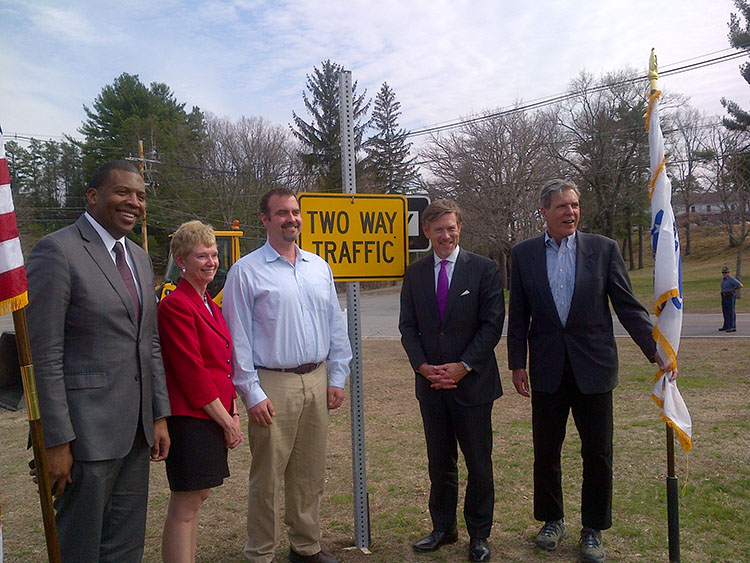Commerce Blog
October 29, 2014
 In the two years since Hurricane Sandy made landfall on October 29, 2012, the Department of Commerce, through its National Oceanic and Atmospheric Administration (NOAA), Economic Development Administration (EDA), Census Bureau, National Telecommunications and Information Administration (NTIA), and National Institute of Standards and Technology (NIST), has been working to help communities recover and enhance resiliency in the face of future storms.
In the two years since Hurricane Sandy made landfall on October 29, 2012, the Department of Commerce, through its National Oceanic and Atmospheric Administration (NOAA), Economic Development Administration (EDA), Census Bureau, National Telecommunications and Information Administration (NTIA), and National Institute of Standards and Technology (NIST), has been working to help communities recover and enhance resiliency in the face of future storms.
Hours after the storm hit, NOAA’s National Geodetic Survey began aerial survey missions to assess storm damage. In total, 1649 miles of coastline were documented. The photos taken on these missions provided emergency and coastal managers with the information they needed to develop recovery strategies, facilitate search-and-rescue efforts, identify hazards to navigation and HAZMAT spills, locate errant vessels, and provide documentation home and business owners needed to assess damages to property. To date, FEMA has used the NOAA-supplied photos, as well as those from the Civil Air Patrol, to determine damage to 35,000 homes.
> Read more
Commerce Blog
By Jay Williams, Assistant Secretary for Economic Development
October 3, 2014
 When I was growing up, manufacturing work was all about having a strong back and a strong work ethic. These days, manufacturing has changed. The first Friday in October each year marks Manufacturing Day, and today more than 1,500 manufacturers nationwide are opening their doors to host open houses, public tours, career workshops, and other events, in order to show people what manufacturing is – and what it isn’t. There is a lack of understanding of present-day manufacturing environments, which are highly technical. Manufacturing Day provides manufacturers with the opportunity to address the skilled labor shortage they face, connect with future generations, take charge of the public image of manufacturing, and ensure the ongoing prosperity of the whole industry.
When I was growing up, manufacturing work was all about having a strong back and a strong work ethic. These days, manufacturing has changed. The first Friday in October each year marks Manufacturing Day, and today more than 1,500 manufacturers nationwide are opening their doors to host open houses, public tours, career workshops, and other events, in order to show people what manufacturing is – and what it isn’t. There is a lack of understanding of present-day manufacturing environments, which are highly technical. Manufacturing Day provides manufacturers with the opportunity to address the skilled labor shortage they face, connect with future generations, take charge of the public image of manufacturing, and ensure the ongoing prosperity of the whole industry.
In honor of Manufacturing Day, I was joined by Kansas Governor Sam Brownback and faculty members for an event at Wichita State University (WSU) in South Kansas. The region is a leader in manufacturing, and the University is a key member of the South Kansas Manufacturing Community consortium, which U.S. Secretary of Commerce Penny Pritzker announced as one of the 12 Investing in Manufacturing Communities Partnership (IMCP) designated communities in May. While there, I announced a $1.9 million EDA grant to WSU to support advanced manufacturing.
> Read more
October 2014 Newsletter
 If you build it, they will come. But what if it’s built and no one knows it? In the United States, there are hundreds of millions of square feet of nonproductive commercial, industrial, and manufacturing space. This space provides an opportunity for domestic companies to find manufacturing spaces as well as foreign companies looking to locate operations in the United States. However, information about this space can be incomplete and scattered. That’s where NEXCAP comes in.
If you build it, they will come. But what if it’s built and no one knows it? In the United States, there are hundreds of millions of square feet of nonproductive commercial, industrial, and manufacturing space. This space provides an opportunity for domestic companies to find manufacturing spaces as well as foreign companies looking to locate operations in the United States. However, information about this space can be incomplete and scattered. That’s where NEXCAP comes in.
With funding from EDA, the National Excess Manufacturing Capacity Catalog (NEXCAP) is uniquely and comprehensively cataloging these vacant manufacturing facilities, their assets, and those of the surrounding community. The searchable catalog offers companies seeking manufacturing production sites/facilities in the U.S. a complete and detailed overview of potential manufacturing sites. NEXCAP's site inventory and portal is populated with detailed profiles of the facilities and their host communities. It provides companies seeking locations with a toolkit of information to guide their business location and/or expansion decisions. This benefits the communities with properties by attracting investment and new, job creating industries.
> Read more
October 2014 Newsletter
 The importance of manufacturing to the American economy is undeniable. Economic development is crucial to supporting manufacturing communities (and vice versa), and the work many of you do to build infrastructure or develop the local workforce is contributing to the growth of manufacturing across the country. But manufacturing is changing, and its future looks nothing like its history. Rather than focus on offshoring or even “reshoring”—a term used to describe the return of manufacturing to developed markets as wages rise in emerging ones—today’s manufacturing strategies need to concentrate on what’s coming next. The synopsis below is adapted from “Next-shoring: A CEO’s guide,” an essay I wrote with Sree Ramaswamy and Lou Raseey for the McKinsey Quarterly, January 2014. Please visit for a full collection of content on the future of manufacturing. – Katy George
The importance of manufacturing to the American economy is undeniable. Economic development is crucial to supporting manufacturing communities (and vice versa), and the work many of you do to build infrastructure or develop the local workforce is contributing to the growth of manufacturing across the country. But manufacturing is changing, and its future looks nothing like its history. Rather than focus on offshoring or even “reshoring”—a term used to describe the return of manufacturing to developed markets as wages rise in emerging ones—today’s manufacturing strategies need to concentrate on what’s coming next. The synopsis below is adapted from “Next-shoring: A CEO’s guide,” an essay I wrote with Sree Ramaswamy and Lou Raseey for the McKinsey Quarterly, January 2014. Please visit for a full collection of content on the future of manufacturing. – Katy George
Katy George is a director in McKinsey’s New Jersey office; Sree Ramaswamy is a fellow of the McKinsey Global Institute and is based in the Washington, DC, office; and Lou Rassey is a principal in the Chicago office.
Evolving demand from new markets places a premium on the ability to adapt products to different regions. Meanwhile, emerging technologies that could disrupt costs and processes are making new supply ecosystems a differentiator. Accordingly, a next-shoring perspective emphasizes two forms of proximity: to demand and to innovation.
> Read more
October 2014 Newsletter
 Manufacturing built many parts of this country. It created hundreds of jobs and enabled the birth of the middle class. But over the years, some manufacturing communities have seen decline due to outsourcing or changes in the market. Yet, through the fluctuations and changes, the sense of pride in American manufacturing hasn’t diminished. Today, manufacturing is experiencing a renaissance in the United States. Companies are bringing operations back to the U.S., entrepreneurs are bringing new products to market, and the industry is evolving to and adapting to new technologies. Manufacturing is creating jobs – jobs that are high-paying. But, it’s also helping the economy. For every $1.00 spent in manufacturing, the sector generates $1.32 for the U.S. economy. EDA understands the crucial importance of manufacturing to the economic recovery and to future economic growth.
Manufacturing built many parts of this country. It created hundreds of jobs and enabled the birth of the middle class. But over the years, some manufacturing communities have seen decline due to outsourcing or changes in the market. Yet, through the fluctuations and changes, the sense of pride in American manufacturing hasn’t diminished. Today, manufacturing is experiencing a renaissance in the United States. Companies are bringing operations back to the U.S., entrepreneurs are bringing new products to market, and the industry is evolving to and adapting to new technologies. Manufacturing is creating jobs – jobs that are high-paying. But, it’s also helping the economy. For every $1.00 spent in manufacturing, the sector generates $1.32 for the U.S. economy. EDA understands the crucial importance of manufacturing to the economic recovery and to future economic growth.
In FY2014, EDA invested in 89 manufacturing projects, totaling nearly $78 million. The projects were diverse, representing different industries, different geographies, and different community needs – much like manufacturing itself. EDA supported these projects in a number of different ways.
> Read more
 In the two years since Hurricane Sandy made landfall on October 29, 2012, the Department of Commerce, through its National Oceanic and Atmospheric Administration (NOAA), Economic Development Administration (EDA), Census Bureau, National Telecommunications and Information Administration (NTIA), and National Institute of Standards and Technology (NIST), has been working to help communities recover and enhance resiliency in the face of future storms.
In the two years since Hurricane Sandy made landfall on October 29, 2012, the Department of Commerce, through its National Oceanic and Atmospheric Administration (NOAA), Economic Development Administration (EDA), Census Bureau, National Telecommunications and Information Administration (NTIA), and National Institute of Standards and Technology (NIST), has been working to help communities recover and enhance resiliency in the face of future storms.


 When I was growing up, manufacturing work was all about having a strong back and a strong work ethic. These days, manufacturing has changed. The first Friday in October each year marks
When I was growing up, manufacturing work was all about having a strong back and a strong work ethic. These days, manufacturing has changed. The first Friday in October each year marks  If you build it, they will come. But what if it’s built and no one knows it? In the United States, there are hundreds of millions of square feet of nonproductive commercial, industrial, and manufacturing space. This space provides an opportunity for domestic companies to find manufacturing spaces as well as foreign companies looking to locate operations in the United States. However, information about this space can be incomplete and scattered. That’s where NEXCAP comes in.
If you build it, they will come. But what if it’s built and no one knows it? In the United States, there are hundreds of millions of square feet of nonproductive commercial, industrial, and manufacturing space. This space provides an opportunity for domestic companies to find manufacturing spaces as well as foreign companies looking to locate operations in the United States. However, information about this space can be incomplete and scattered. That’s where NEXCAP comes in. The importance of manufacturing to the American economy is undeniable. Economic development is crucial to supporting manufacturing communities (and vice versa), and the work many of you do to build infrastructure or develop the local workforce is contributing to the growth of manufacturing across the country. But manufacturing is changing, and its future looks nothing like its history. Rather than focus on offshoring or even “reshoring”—a term used to describe the return of manufacturing to developed markets as wages rise in emerging ones—today’s manufacturing strategies need to concentrate on what’s coming next. The synopsis below is adapted from “
The importance of manufacturing to the American economy is undeniable. Economic development is crucial to supporting manufacturing communities (and vice versa), and the work many of you do to build infrastructure or develop the local workforce is contributing to the growth of manufacturing across the country. But manufacturing is changing, and its future looks nothing like its history. Rather than focus on offshoring or even “reshoring”—a term used to describe the return of manufacturing to developed markets as wages rise in emerging ones—today’s manufacturing strategies need to concentrate on what’s coming next. The synopsis below is adapted from “ Manufacturing built many parts of this country. It created hundreds of jobs and enabled the birth of the middle class. But over the years, some manufacturing communities have seen decline due to outsourcing or changes in the market. Yet, through the fluctuations and changes, the sense of pride in American manufacturing hasn’t diminished. Today, manufacturing is experiencing a renaissance in the United States. Companies are bringing operations back to the U.S., entrepreneurs are bringing new products to market, and the industry is evolving to and adapting to new technologies. Manufacturing is creating jobs – jobs that are high-paying. But, it’s also helping the economy. For every $1.00 spent in manufacturing, the sector generates $1.32 for the U.S. economy. EDA understands the crucial importance of manufacturing to the economic recovery and to future economic growth.
Manufacturing built many parts of this country. It created hundreds of jobs and enabled the birth of the middle class. But over the years, some manufacturing communities have seen decline due to outsourcing or changes in the market. Yet, through the fluctuations and changes, the sense of pride in American manufacturing hasn’t diminished. Today, manufacturing is experiencing a renaissance in the United States. Companies are bringing operations back to the U.S., entrepreneurs are bringing new products to market, and the industry is evolving to and adapting to new technologies. Manufacturing is creating jobs – jobs that are high-paying. But, it’s also helping the economy. For every $1.00 spent in manufacturing, the sector generates $1.32 for the U.S. economy. EDA understands the crucial importance of manufacturing to the economic recovery and to future economic growth.